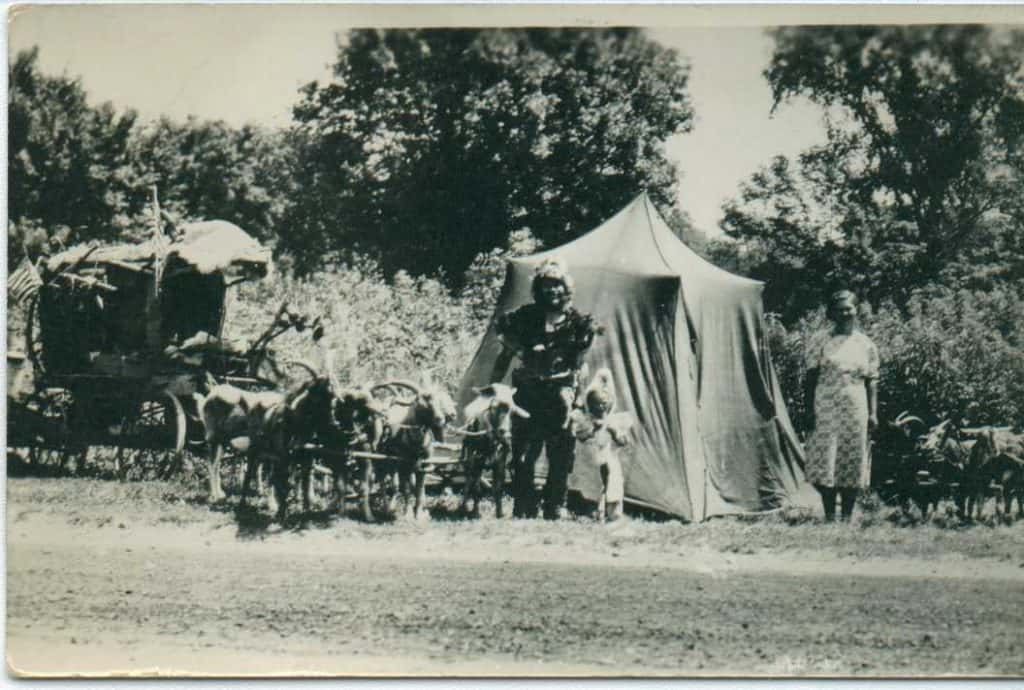Rural American Legend:
The Goat Man
Written by Justin D. Lamb

Goat Man in Hardin in the early 1930s
(Doak Printing Company, Manchester, TN)
Rural America has given birth to many colorful characters and legends. Perhaps one of the most intriguing is the story of Charles “Ches” McCartney, or as he was better known, “The Goat Man.” For decades, the Goat Man wandered across rural American back roads with “a massive iron-wheeled wagon loaded with pots, pans, pails, bales of hay lead by a team of goats, sometime as many as 30 goats.” With his tattered clothes and long, scraggly beard, the Goat Man would make stops in several small towns preaching the Gospel with anyone who would listen. It was once written “the Goat Man was the essence of freedom. He wandered around rural highways of America at a goat’s pace, unfettered to schedules, clocks, or calendars.”
The story of the famous Goat Man began when McCartney was born on July 6, 1901 in Sigourney, Iowa. By a very young age, he had already gained a reputation as an eccentric character. By the age of 14, he left his Iowa hometown for New York where he married a Spanish woman and became a part of her knife-tossing act in local shows.
By the 1930s, the Goat Man became injured while working with the Works Progress Administration and had a “religious awakening.” Legend has it that McCartney was thought to be dead and awoke when the funeral director was putting the embalming needle into his arm. He interpreted his brush with death as a calling and he soon took to the road with his wife and son along with a team of goats to preach.
As he traveled across America, his fame grew and as did the large curious crowds who would gather in small rural towns to hear the Goat Man preach his fiery sermons. “His path through the countryside was easily traceable from the distinctive wooden signs he tacked on the trees by the roadside, signs bearing such harsh messages as “Prepare to Meet Thy God” with the fires of hell painted underneath.”
Since his childhood days on the family farm, McCartney had always been fond of goats, and he came up with the idea of using a goat cart to travel with his family and work as a traveling preacher. McCartney was taken with the book Robinson Crusoe, and carried a copy of it, along with a Bible, throughout his travels. Robinson Crusoe inspired him to dress himself and his son Albert in goat skins. It also possibly inspired his independent lifestyle, in which he lived off the land, the contributions of strangers, and his goats.
His diet consisted of goat milk, in addition to food given to him or bought with money he made selling post cards of himself or from posing for pictures. The Goat Man had no difficulty attracting attention and by many accounts he was said to be friendly and quick to share an inspiring sermon. By most accounts he smelled very badly much like goats he traveled with which added to his persona. There were rumors that he was rich, and the Goat Man was mugged many times on the road.
However, soon the road deemed too much for the Goat Man’s wife and she returned to their home in Iowa leaving the Goat Man and their son on the road alone. One legend says that McCartney sold his wife to another farmer for $1,000.
According to Goat Man historian Duane Branam, “The Goat Man walked 100,000 miles preaching the gospel in 49 of the nation’s 50 states from 1937 to 1987. If stories are true, he wrestled a bear, was nearly lynched by the Ku Klux Klan, was once thought dead and taken to the morgue, got ordained as a preacher and got mugged in LA trying to see actress Morgan Fairchild.”
On many of his journeys, the Goat Man visited Marshall County on a few occasions throughout the years stopping at various places including Benton and Hardin. William L. Jones of Fairdealing recalled a time when the Goat Man visited. “We moved to Benton in 1946 and the Goat Man would come through the area several times in the late ‘40s and early 50’s,” Jones recalled. “He would set up at the north end of town near the S-curve and he had a team of goats pulling his wagon,” Jones said. “A lot of people would come to see him and we would talk to him because as kids we were fascinated by him,” Jones recalled.
After years of traveling, the Goat Man retired from the road in 1987 when he entered a nursing home in Macon, Georgia. He soon became a local celebrity and several books and a song was written about him and his travels. In November 1998, “The Goat Man” Charles McCartney passed away at age 97.
